Links to the future…
In our final week of the course, all of my peers created exceptional presentations of dystopias, utopias, and the direction of where technology might end up moving forward.
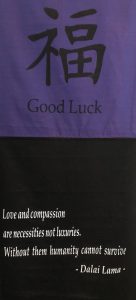 One peer in particular, Margaret Irwin, a Foods Teacher, chose to imagine and design a twine game where all citizens have “equal access to food.” The game pits a government subsidized program against independent organic model in order to envision food equity and equality of the future. What went wrong? Was there too much change too quickly?
One peer in particular, Margaret Irwin, a Foods Teacher, chose to imagine and design a twine game where all citizens have “equal access to food.” The game pits a government subsidized program against independent organic model in order to envision food equity and equality of the future. What went wrong? Was there too much change too quickly?
The game is powerful as it provides autonomy for the player, but only once. “You must make a choice today.” This is the power of conscious decision making, of reflecting on the permanence and impermanence of our individual and collective actions. The language used throughout the game is subtle, yet powerful. The ‘considerations’ one must make in organic farmer, as opposed to the ‘implications’ of following a government run food program. Both options for the future of food are presented as positive sustainable options, yet the underlying factors of homogenizing a population through the one-size-fits-all approach aligns with many of the themes explored in dystopian predications from our class, including increased reliance and dependence, skill degeneration, hacking the algorithm, and loss of practices.
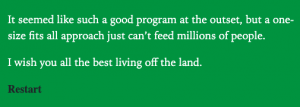
Margaret’s blog is provides many links for accessing past work and comments, as opposed to my scrollable interface. Her blog presents the title and date before the title, unlike my own. In my blog entry, I provided a visualization which prompted my narratives of a grassroots educational setting and an elitist technological economy. Providing an audio narrative gave emotion and pace to the community focused narrative, while an angular word cloud and text provide information on the socially detached possibility. Margaret was able demonstrate this distinction within one medium, Twine. Using the viewers agency, she developed an interactive hypertext game with two paths for the future of food, similarly, I created my blog as a continuous document, one continuous path of my process and development.
Linking Alternative Approaches
In my post on the Network Assignment: Using Golden Record Curation Quiz Data, I was connected with ten of my peers, some who I have taken previous classes with in the MET program and others who I have made connections with through the linking assignments, notably Brian and Katelyn. However, I was not connected with one of my peers, Andrew Shedden, and in his post, he devised insightful questions as grounds for understanding our classes’ selections.
Andrew’s blog is arranged similar to the orientation of a piece of paper, and his focus is textual. He numbers his three main points of distinction about our community of practice and highlights certain questions and sentence fragments in bold to emphasize certain ideas. Andrew highlights these three questions as driving points of the subjective factors which influence musical curation.
How does educational attainment influence musical taste?
How do economic realities influence musical taste?
How does educational pursuit influence musical taste?
Andrew concludes by stating, “Looking at my choices, as objective and removed from the decision as I tried to make myself, I still ended up mainly choosing songs that I had a pre-existing relationship with. Did others due the same (regardless of their justification)?” I would argue that the song selections are reflections of the factors Andrew mentioned, but also reflect environment, culture, and methods of learning.
In my post, I wanted to further investigate graph theory and work to understand the reasons for not only connection among others, but the absence of connection. As mentioned in my post, “I averaged the amount of links that Brian, Katlyn and myself had to others…. there was roughly a 60% rate of connection among all group members and the group was more interconnected than sparsely connected.” In reflecting on these connections a few weeks later, I see clear patterns that connect our thinking and construction of knowledge through similar cultural reference points and methodological approaches, which illustrates further why the three of us are interconnected in multiple ways. Without intention, I have written linking assignments to both Brian and Katlyn’s work. Coincidence? I don’t believe in them.
Andrew posed another question in his work, “To what extent do our group’s similarities bring our opinions about music together?” Andrew described his process of listening in detail, and although I do not have the same musical equipment, I engaged in a very similar process. At the beginning of my post, I reference subway systems data and the need for qualitative data to provide information on ability, and access to increase ease of use for all people. By reviewing the work of my peers who has an alternative way of approaching the data, who I am more sparsely connected with in the Using Golden Record Curation process, it highlights to me the importance of the multiple factors that bring people together in communities of practice and the importance of diverse expressions of meaning in order to trigger new ways of approaching the data. To rephrase his question, to what extent do our group’s differences advance our understanding of our own opinions about music and relation to one another?
Linking the Emotional Response
How can we be humble and authentic in a fast-paced online world of deception? What is time well spent?
In this blog entry, I look at the reactions of my peers to playing the game User Inyerface. It is common people will respond emotionally when playing games. There was a variety of reactions, ranging from anxiety provoking in Tyler, to determination through speed in Katelyn. However, in Brian’s post, he deviates from the norm among our peers and focuses on how much people fail to read the universal symbols and uses specific examples to illustrate how the attention economy is impacting our social, emotional, and psychological health. He looks at the practices of autofilling information and how it facilitates fast tracked action, which can contribute more generally to having less patience and compassion. From a business perspective, Brian reasons that “Companies are motivated to do this [enable cookies to autofill forms], because every little thing that increases frustration or causes us to lose interest is one less potential sale or data input for advertising.” This leads to the speculation of the attention economy’s effect on our humanity…
Does participation lead to a lack of patience and understanding? How does being wired by the practices of social media and psychological manipulation in online games change our social interactions, emotional responses, and disconnect us from our physical and spiritual selves? How can we remain connected with ourselves, our own passions and desires, without interference by AI?
As mentioned by Tristan Harris in his Ted Talk, social media algorithms are taking away our agency by changing the ways we want to converse and changing democracy. Brian’s thoughts from his blog are applicable not only to the game, but to the ways in which social media sites can influence choice by design. “By utilizing our common design language, you can both trick people into clicking things they didn’t intend to, and you can convince them that one option is preferable to others by designing it in a way that users associate with the right choice.”
Finally, Kristin mentions that “every single step is created to slow you down,” which makes me question our collective approach as teachers within our fast-paced evolving world. Carla included the youtube video “Can We Auto-Correct Humanity?” where they presented the information, “study’s show that the average attention span of adults today is one second slower…than a goldfish.” Along every single step of progress, we need to think critically as teachers to inform ourselves and question the messages we are promoting.
Speculative Futures
Which direction will education take in our global village in 30 years?
I think our world will either be shaped by a restructuring of education, healthcare, and technology to provide a more localized and equitable distribution/access to goods and services… or as a continuation on our current path where billionaires and the wealthy contribute to furthering the inequitable divide based on geography, race, power, and ability.

Change as a result of growing global inequality, race relations and unethical artificial intelligence could allow us to lean left, where an increased focus on creativity, innovation, and interdependence shapes our future. In the following voice recording, I comment on different aspects of a utopian school culture, focusing on fostering connection, belonging and acceptance, and competence for all people in society to make valuable contributions.
 In moving towards the right side, I envision an increasingly polarized society where the increasing disparity in wealth globally leads to more violence and extraction of resources. This causes an acceleration of the climate crisis and more violence globally. In this highly digitized world online, there becomes a growing concern with the individual and disregard for the billions of other people on the planet who face famine and natural disaster at an alarming rate. Choices the wealthy and powerful leaders of the 2020s- 2050s become increasingly authoritarian and competitive, which reignited the Cold War and previous global conflicts over finite resources.
In moving towards the right side, I envision an increasingly polarized society where the increasing disparity in wealth globally leads to more violence and extraction of resources. This causes an acceleration of the climate crisis and more violence globally. In this highly digitized world online, there becomes a growing concern with the individual and disregard for the billions of other people on the planet who face famine and natural disaster at an alarming rate. Choices the wealthy and powerful leaders of the 2020s- 2050s become increasingly authoritarian and competitive, which reignited the Cold War and previous global conflicts over finite resources.
A privileged student may go to an elite private school, an artificially constructed city as a bubble, where people live their lives constantly inside a physical bubble to protect them from the outside world. Living on the side would be reserved for the elite wealthy and students of these families would continue to learn amongst one another of the history and evolution of society. All knowledge would be accessible through AI robots and living in this polarized world would demonstrate the necessity to hoard the worlds resources for only the wealthy in order to sustain themselves and their kin. Children in classes could watch as natural disasters affect other parts of the world and do group work to predict the next crisis and attempt to warn the public, but ultimately, the elite class would only be concerned for their own health and well-being as they create artificial methods for producing food and all the resources necessary for their own survival.
Will the future be friendly? Will there be greater divisions among humankind or greater accountability to provide for and sustain everyone?
Attention Economy
Aside from the final Gif of of the ‘Carlton dance,’ I did not enjoy trying to solve this problem. I played for about twenty minutes one day and then gave up because I felt it was a waste of my time. I love games, puzzles, and cooperative work, but the User Inyerface game by Baggar.be is a game of deception, reminiscent of the frustrations faced in online interactions. Returning to the game a few days later, I was more aware of the puzzles and tricks the site may use to challenge the player. Many aspects of the game serve the purpose of “a baggar frustration”, such as the timing box, matching the age range with only four possible months and 120 years, the hidden options of select all or unselect all, and the help box that notes you are the 457th person in line. I wonder if this is how my Grandmother felt when she would call me and ask for help logging on to her facebook…

The practices employed in this game are referred to as dark patterns, and as Tristan Harris mentions in his Ted Talk, “How a handful of tech companies control billions of minds every day,” internet companies compete in a race for attention and use persuasion tactics that have become more visceral and covert to appeal to human’s lizard brain. This reminds me of the book by Martha Hamilton, “Going Reptile,” as it looks how situations at work and in personal relationships trigger action or inaction – “the reptile inside us.” Looking further at online marketing practices, guides suggest appealing to pain, fear, emotion, and ego. As Harris mentions in his Ted Talk, we need to reimagine what is time well spent and hopefully go further to change the capitalist systems of inequality which pray on the lizard brain and insecurities of humanity. It seems much easier to quit and cancel all social media than to demand equitable change to this corrupt system.
Harris, T. (2017). How a handful of tech companies control billions of minds every day. Retrieved from https://www.ted.com/talks/tristan_harris_the_manipulative_tricks_tech_companies_use_to_capture_your_attention?language=en
Connecting the Dots
What do visualizations of network connections show us about commonalities and patterns? Creating graphs with the available data from our class’s selections of top ten songs from the Voyager Gold Album immediately grouped data into five sets and organized people based on similarities of their preference.
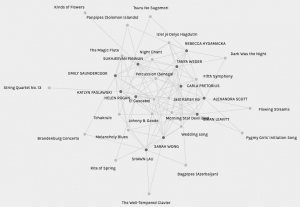
Group 5 Graph
A challenge in interpreting this data is finding the relevance and practical applicability of preference as noted through the curation of 10 songs from the Voyager Gold Album. In a quantitative network graph of a subway system, where nodes are central to the modelling of the system and are ranked based on number of links or length of pathway in order to model risk or interruptions and the effect on the entire system, the data collected may not provide information on personal issues of accessibility or reasoning for chosen pathways, and therefore a mix of quantitative and qualitative data provides more information to interpret the graph.
The Pallidio graphs can manipulate the data to display the most and least connections. The song, Jaat Kahan Ho has 31 connections, the most of all the tracks, whereas Panpipes and the Fairie Round both have the least amount of connections, connecting to 5 people and not one student overlaps among the two lowest rated songs.
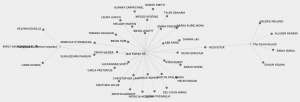
The most connections vs. the least connections
This screenshot of the graph demonstrates an understanding of preference among the group, where individual difference is accounted for and incorporated into the larger data set.
Narrowing the Focus
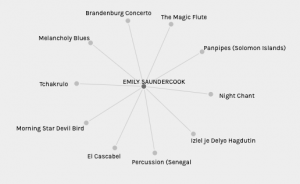
My choices
In the data set, ‘Group 5,’ my curation was aligned with 10 other classmates to form a group of 11. Isolating different elements of this group provides a clear picture of song selections and the song that connected our entire grouping, ‘El Cascabel.’ In Group 5, there were multiple nodes with many connections, ‘El Cascabel’ with 11 connections,
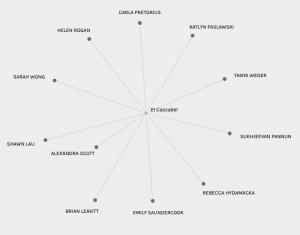
The song that connected all of group 5
‘Jaat Kahan Ho’ with 10 connections and ‘Percussion Senegal’ with 9 connections. Additionally, there were seven nodes that had two connections, five nodes that had six connections and three nodes that had eight connections. By grouping the data, it is clear that Group 5 was connected based on multiple nodes demonstrating the cohesiveness of the group based on interconnection of choices. The similarity of preference is further evidenced by
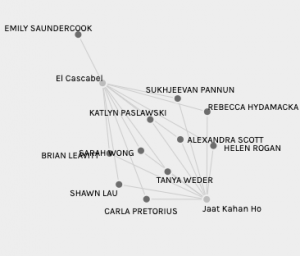
Similar Preference with Individual Difference
the selection of both ‘Jaat Kahan Ho’ and ‘El Cascabel,’ however, individual difference is noted as I am the lone outlier of the group. Individuality of selection is represented only twice in Group 5 as only two nodes exist with one person. To further illustrate how alike members of Group 5 were in their selections, I averaged the amount of links that Brian, Katlyn and myself had to others by adding the total connections from each node and dividing by ten nodes. The averages were: Brian, 6, Katlyn, 6.5, and Emily, 6. Therefore within Group 5, there was roughly a 60% rate of connection among all group members and the group was more interconnected than sparsely connected.
Connecting the dots with other data visualizations
The following site, https://hedonometer.org/timeseries/en_all/, provides a data visualization for the project “Average Happiness for Twitter.” This project, similar to our class data, provides general trends that connect large groups of people. This project provides information on a global scale and provides key events and dates in order to understand the importance of holidays and the reception of major news stories. Looking at these patterns is only part of the story, yet provides insight into how individuals rank events (like song choices) as important aspects in their daily lives.
Selected Songs from the Voyager Gold Record
Selected Songs:
All of the songs we annotated based on my personal connection to the music and sounds. The songs selected evoked the strongest memory, connection, or desire to smile, dance and be present. As noted in the podcast by Dallas Taylor, the Voyager Gold Album is described as collection of human values from around the world. Through its creativity, the artistic human imagination and intellect reaches out the unknown. My favourite line from the podcast, was the quote:
Imagination is more important than knowledge. – Albert Einstein
Bach, Brandenburg Concerto No. 2 in F. First Movement, Munich Bach Orchestra, Karl Richter, conductor. 4:40
This song was selected because of my connection with the trumpets. I played trumpet for three years in my school band and appreciate this instrument greatly. The song is full of bright and uplifting harmonies and rhythms.
Senegal, percussion, recorded by Charles Duvelle. 2:08
The drums, especially the hand drums, remind me of tamtams in Montreal. A weekly improvised collection of people on Mount Royal making music, and an audience learning to move their body in time and feel the music run through them. This music speaks to the power of expression, no matter the state – from celebration to sadness.
Australia, Aborigine songs, “Morning Star” and “Devil Bird,” recorded by Sandra LeBrun Holmes. 1:26
This chanting song cultivates a community feeling of belonging and connection. The chorus of men chanting feels as though they are bonded to something beyond themselves, perhaps to the land and to one another.
Mexico, “El Cascabel,” performed by Lorenzo Barcelata and the Mariachi México. 3:14
This is a very famous song I have heard many times before and heard other pop songs who have sampled from this song. The instruments of a Mexican guitar and fiddle make me tap my feet and get up to move and dance. I dream of learning Latin dances, like the salsa and merengue.
Mozart, The Magic Flute, Queen of the Night aria, no. 14. Edda Moser, soprano. Bavarian State Opera, Munich, Wolfgang Sawallisch, conductor. 2:55
Looking into the story of this Opera, I found that the Queen of the Night must exact revenge, and it reminds me of growing up with my sisters and always trying to get back at one another in sneaky ways. Watching the BBC version, the female vocalist demonstrates strength, power, honour and passion in her singing of a primal rage aria. I connect deeply with the illusion of choice within the story and would love to see it performed live.*
Georgian S.S.R., chorus, “Tchakrulo,” collected by Radio Moscow. 2:18
In one of the very bars in the song, there is a long ‘o’ sound that I immediately connected with a song from the movie Frozen. The chorus sounds are similar to an organ or voices in a church, and it was interesting to read how people from Georgia are connected to this piece of history. The architecture of sound within building of worship reminded me of visiting the Rothko Chapel and appreciating the space, art and sound as a spiritual experience.
“Melancholy Blues,” performed by Louis Armstrong and his Hot Seven. 3:05
I am very fond of Louis Armstrong, especially his song, What a Wonderful World. I wonder why they chose this song in particular, as it does not feature prominently his unique voice or the stories he spins with sound. The Blues makes me think of visiting New Orleans, attending many Montreal Jazz Festivals over the years, and doing research on the history of jazz in Montreal and learning about race relations and the famous Jazz club Rockhead’s Paradise.
Bulgaria, “Izlel je Delyo Hagdutin,” sung by Valya Balkanska. 4:59
I always love folk songs and the stories they tell. My favourite festival in Montreal is the Folk Fest sur le Canal. The subject of this song, a rebel leader oppressed by tyrants and the women who mourn, is a homage to the strength of people and the human spirit.
Navajo Indians, Night Chant, recorded by Willard Rhodes. 0:57
The rattles in this song remind me of learning about how the Cree People would make rattles out of turtle shells or nut shells. When I lived in Mistissini, I had the chance to learn to sing the woman part of some traditional songs from Gabriel Whiteduck.
Solomon Islands, panpipes, collected by the Solomon Islands Broadcasting Service. 1:12
The panpipes bring to mind a much more simplistic train whistle I had as a child, the melodies make me think of the movement of a train chugging along and of adventure that awaits. The sounds move through me and transport me to an unknown destination and I am content.

*My ability to research the origins of some songs over others influenced some of the connections I was able to make and may have tipped my selection to include more English or Westernized music, rather than just basing my selection on the connection I felt towards the music.
As Abby Smith noted in her talk, Digital Memory: What Can We Afford to Lose, our cultural memory is exclusive and strongly linked to our own identity and the barriers of what we have experienced. I would like to learn more about the songs that I was particularly disinterested by, in order to build a greater tolerance and appreciation for cultural difference.
Not Selected:
Java, court gamelan, “Kinds of Flowers,” recorded by Robert Brown. 4:43
Very calming chanting.
Zaire, Pygmy girls’ initiation song, recorded by Colin Turnbull. 0:56
Meditative chanting or prayer song.
“Johnny B. Goode,” written and performed by Chuck Berry. 2:38
Classic rock and roll, from my memories of the movie Pulp Fiction and dressing up as Mia Wallace for Hallowe’en.
New Guinea, men’s house song, recorded by Robert MacLennan. 1:20
My ears are sensitive to the sounds of crackling on the recording.
Japan, shakuhachi, “Tsuru No Sugomori” (“Crane’s Nest,”) performed by Goro Yamaguchi. 4:51
I have very little cultural reference to appreciate this piece and the tones in the Japanese flute. I would love to learn more.
Bach, “Gavotte en rondeaux” from the Partita No. 3 in E major for Violin, performed by Arthur Grumiaux. 2:55
The violin is very relaxing, familiar and enjoyable to listen to.
Peru, panpipes and drum, collected by Casa de la Cultura, Lima. 0:52
This reminds me of playing band, the noisy environment of the classroom, and the challenges I faced playing at the right time as I could not always hear the cues or keep time by reading the music.
Azerbaijan S.S.R., bagpipes, recorded by Radio Moscow. 2:30
In my Wikipedia search, I learned about the Mugham, and it is unlike Western modes of music. This reminds me of oral storytelling and how you make a story your own and pass it on for someone to shape it and retell it. I would love to see someone play a Muhgam.
Stravinsky, Rite of Spring, Sacrificial Dance, Columbia Symphony Orchestra, Igor Stravinsky, conductor. 4:35
The Rite of Spring is suspenseful and serious. I did not like the ballet interpretations I saw online. The song feels like an impending doom is approaching and to respect the strength of the ever-moving natural world.
Bach, The Well-Tempered Clavier, Book 2, Prelude and Fugue in C, No.1. Glenn Gould, piano. 4:48
This calm, soothing, beautifully played classical piano is nothing like the piano I played growing up. I sounded much more like a cat walking across the keys.
Beethoven, Fifth Symphony, First Movement, the Philharmonia Orchestra, Otto Klemperer, conductor. 7:20
This song reminds me of the Nutcracker. I went to see this a few times with my family, put on in a church not far from our home in Toronto. My search online led me to this video, a remix of the music and dancing, and I find it amazing how people are able to create such well timed mashups.
Holborne, Paueans, Galliards, Almains and Other Short Aeirs, “The Fairie Round,” performed by David Munrow and the Early Music Consort of London. 1:17
The title creates a clear connection between the light sounds and going to a Country Fair.
Peru, wedding song, recorded by John Cohen. 0:38
This Wedding Song sounds so sad. As though waves lapping upon a beach showing the repetition of each day going through life.
China, ch’in, “Flowing Streams,” performed by Kuan P’ing-hu. 7:37
The sounds of water and earthy tones through a slide guitar is tranquil, calming, and reflective.
India, raga, “Jaat Kahan Ho,” sung by Surshri Kesar Bai Kerkar. 3:30
To me, these are the Indian sounds of enduring and moving forward. The music reminds me of an Indian celebration I was invited to, a ‘period party’ for a student of mine. There was so much colour and life to the party, many pictures were taken, and lots of delicious Indian food.
“Dark Was the Night,” written and performed by Blind Willie Johnson. 3:15
Perseverance; optimism; enduring; praise.
Beethoven, String Quartet No. 13 in B flat, Opus 130, Cavatina, performed by Budapest String Quartet. 6:37
A sad, yet hopeful ending of sorts. A tribute to the unknown in B-Flat, a somber salute to the universe.
Linking Multiliteracies
In our tasks on Mode-Bending, Laura Ulrich’s post was an exploratory and interactive musical cacophony compared to my design of an artistic reflection on the backpack as a container of knowledge. Embedded in each post are relationships with the objects, relating to the principles of constructivism and the New London Group on multiliteracies.
“In a pedagogy of multiliteracies, all forms of representation, including language, should be regarded as dynamic processes of transformation rather than processes of reproduction. That is, meaning makers are not simply replicators of representational conventions. Their meaning-making resources may be found in representational objects, patterned in familiar and thus recognizable ways. However, these objects are reworked. Meaning makers do not simply use what they have been given: they are fully makers and remakers of signs and transformers of meaning” (Cope & Kalantzis, 2009, pg. 175).
The representations we created contrast in the self-organization of information. Laura’s relationship to the objects connect with memories of her childhood and travels, or the mood and feelings when interacting with an object. The meanings refer to the present moment and can be played simultaneously or repetitively, symbolizing the interconnection of self with environment and inability to isolate an experience or object from experience and emotion. The intertextual meanings of her work can fit into the layering of identity and the construction of portraying that identity through a digital medium.
We take alternative paths, as I look to contrast traditional and modern approaches to prose and Laura begins her post with the quote signifying her jumping with two feet into the unknown.
“GET IN OVER YOUR HEAD AS OFTEN AND AS JOYFULLY AS POSSIBLE.” –ALEXANDER ISLEY
Certain quotes from the course text are used throughout my post, ‘Diverse Discourse,’ to provide context for the minimalist story and animation as a metaphor for the capacity of objects to encompass feeling, reflection, and meaning. The final quote includes the message that “human knowledge is initially developed not as “general and abstract,” but as embedded in social, cultural, and material contexts” (New London Group, 1996, pg. 82). The animation and prose demonstrate personal perspective and creative expression. My stylized thoughts on the page give further indication to my vision of structural representation. Laura presented the challenge to toggle between German and English, which I could have engaged with in speaking and writing in French as well as English. The language associated with each container of knowledge, could have been representative of my academic english, Cree beading style and Quebecois decor. Her post has made me venture further into unfamiliar discourse of multimodality and challenging the binaries of language and layers.
Finally, Laura’s work reminded me of serval tools I have used while teaching. Incredibox and Chrome Music Lab are two resources I did not think to use for this audio task, as like many of my peers, I found it challenging to imagine a task only using audio. If I were to compare our audio tracks, the agency of the viewer is completely transformed in Laura’s work, whereas mine follows a linear progression of an audio visual piece. What would a representation of your audio piece look like in one of the Chrome Music Lab extensions?
References:
Bill Cope & Mary Kalantzis (2009) “Multiliteracies”: New Literacies, New Learning, Pedagogies: An International Journal, 4:3, 164-195, DOI: 10.1080/15544800903076044
The New London Group. (1996). A pedagogy of multiliteracies: Designing social futures. Harvard Educational Review 66(1), 60-92.
Diverse Discourses
Tradition and Modernity
Old and New Practices
Side by Side
Containers of Knowledge
-
- the desk organized
- the journal reflective
- the paints creative
- the computer endless
“New Technologies compete with old ones – for time, for attention, for money, for prestige, but mostly for dominance of their worldview” (Postman, 1996).
Preparation for the future. The Backpack of Privilege. A symbol of learning?
“Ultimately, we suspect that an analysis of who is in the business of maintaining web servers, publishing web materials, designing interfaces, and so on, would likely reveal that a significant digital divide in regards to gender remains. As has been the case with the rise of most communication technologies, from print through television, males are the primary adopters and tend to control the content and format of information diffused through various media irrespective of how audiences change through time (Faulkner,2001; Graff, 1995)” (Dobson and Willinsky, pg. 13).
A case within a case
ideas of preciousness
delicate
handmade
meaningful objects
tell stories of love
through colour
and beads.
A case on the wall:
a bookcase
ideas organized to inspire
reimagined by others in delight
boxes of supplies holding possibility
“Schools regulate access to orders of discourse” (New London Group, 1996, pg. 71).
Transformed from an image and description
to a story of space:
Containers Cases and Space.
to breathe
to work
for focus or fun
to adapt
and reimagine
“Our view of mind, society, and learning is based on the assumption that the human mind as embodied, situated, and social. That is, human knowledge is initially developed not as “general and abstract,” but as embedded in social, cultural, and material contexts. Further, human knowledge is initially developed as part and parcel of collaborative interactions with others of diverse skills, backgrounds, perspectives joined together in particular epistemic community, that is, a community of learners engaged in common practices centered around a specific (historically and socially constituted) domain of knowledge” (New London Group, 1996, pg. 82).
References:
Postman, Neil. (1992). Technolopoly: the surrender of culture to technology. Knopf.
The New London Group. (1996). A pedagogy of multiliteracies: Designing social futures. Harvard Educational Review 66(1), 60-92.
